Part 33: Post Game Things we missed - Buildings (Part 2)
Things we missed - Buildings (Part 2)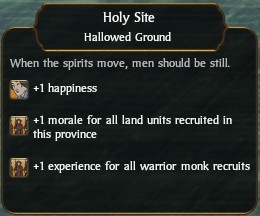
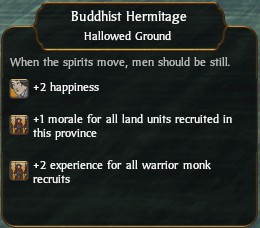
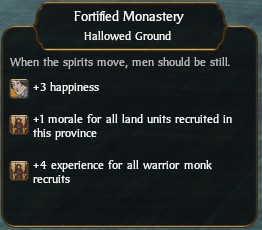
Cost: Free/1250/3500
The first building in the Hallowed Ground chain, Holy Site, increases provincial happiness, rank of warrior monks and morale of units produced here. It can be developed into a Buddhist Hermitage or Shinto Sanctuary. The Buddhist Hermitage further increases provincial happiness and experience for warrior monks. The final building, Fortified Monastery, even further increases provincial happiness and experience for warrior monks.
Ingame encyclopaedia - Holy Site/Buddhist Hermitage/Fortified Monastery posted:
This province has a site of religious significance. By developing this site, more experienced monks can be trained as fanatical warriors. Alternatively, the site can be developed along less martial lines, and bring happiness to all the people of the province. A shrine is not just important because of a building, but because of the place's spirit. People may appreciate the buildings around a shrine, but it is the fundamental sanctity of the place that makes it holy. As long as the kami are respected and honoured, the shrine remains a source of spiritual strength. Today many shrines in Japan are revered historical monuments as well as shrines, and many have been listed as World Heritage Sites.


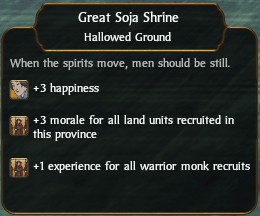
Cost: Free/1350/3500
The first building in the Hallowed Ground chain, Holy Site, increases provincial happiness, rank of warrior monks and morale of units produced here. It can be developed into a Buddhist Hermitage or Shinto Sanctuary. The Shinto Sanctuary further increases provincial happiness and morale for units. The final building, Great Soja Shrine, even further increases provincial happiness and morale for units.
Ingame encyclopaedia - Holy Site/Shinto Sanctuary/Great Soja Shrine posted:
This province has a site of religious significance. By developing this site, more experienced monks can be trained as fanatical warriors. Alternatively, the site can be developed along less martial lines, and bring happiness to all the people of the province. A shrine is not just important because of a building, but because of the place's spirit. People may appreciate the buildings around a shrine, but it is the fundamental sanctity of the place that makes it holy. As long as the kami are respected and honoured, the shrine remains a source of spiritual strength. Today many shrines in Japan are revered historical monuments as well as shrines, and many have been listed as World Heritage Sites.

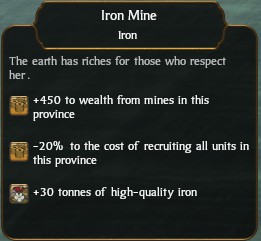
Cost: Free/2400
Iron Sands is the first building in the Iron chain. It increases province wealth, reduces the cost of ground troops and produces the Iron trade good. The Iron mine is the final building in the chain, it increases the wealth to the province, discount to troops and number of Iron trade goods produced even further.
Ingame encyclopaedia - Iron Sands/Small Iron Mine/Iron Mine posted:
This province will produce very good quality iron, a vital resource for weapons. As the mine is developed and expanded, the training cost of units will be greatly reduced, and the province's underlying wealth is also improved. Iron is, perhaps, the most important war-making commodity needed by any great family. Without iron, there are no swords, naginatas, or dreams of glory. Gold is all very well, but wealth can always be squeezed from the peasants through taxes. The same is not true of good iron.
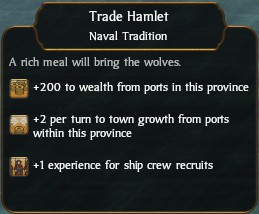
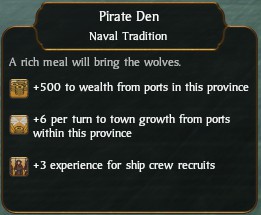
Cost: Free/3570
The first building in the Naval Tradition chain, the Trade Hamlet increases the wealth and growth of the province, as well as the experience of ships produced there. The Pirate Den yet further increases the wealth, growth and experience of ship crews recruited in the province.
Ingame encyclopaedia - Trade Hamlet/Pirate Cove/Pirate Den posted:
This small village boosts the trade income of the province, and its people can be recruited as experienced crews for any ships. Unfortunately, where there is money there are usually bad people trying to take that money. Trade and piracy are often linked more than honest warlords would like to think, for who is to say who owned a particular cargo, and when? Piracy was a curse to all of Japan's neighbours, and often to Japanese merchants as well. What central government there was in Japan did not feel all that inclined to do anything about piracy, if only because the pirates were often the only source of Chinese goods. The Chinese had banned trade with Japan in the hope of starving the pirates of targets; the result was to make the pirates the only importers of stolen Chinese merchandise. From time to time the Chinese descended on particular pirate havens and killed everyone they could. Often that stopped the piracy anything up to a few days.
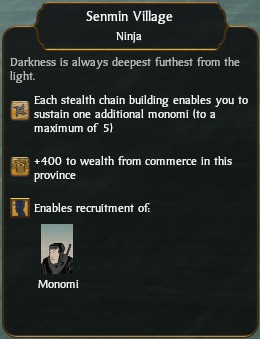
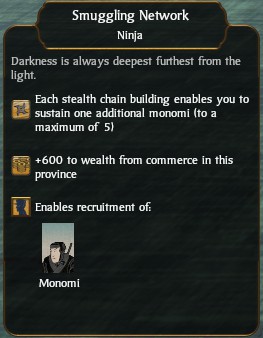
Cost: 1900/3600
The Senmin Village building is the second in the Hamlet chain. It further increases wealth in the province. The final building is the Smuggling Network, which even further increases province wealth.
Ingame encyclopaedia - Isolated Hamlet/Senmin Village/Smuggling Network posted:
Although assassins and criminals are dangerous, troublesome and underhanded, great leaders must sometimes use such people for the greater good. Victors get to dictate histories to scribes and scholars, and the enemy killed in darkness is just as dead as one killed honourably in battle. Equally useful to a clever warlord are the informal business practices of such men: wealth is wealth, after all, and all wrongdoing melts away in the warm glow of gold. Although the killers were not strictly "ninja" at the time of the Gempei War, all sides employed assassins to remove troublesome enemies. Politics, as the Taira demonstrated to the Minamoto, was not so much about defeating your opponents as having them all killed as quickly as possible. Any and all weapons, including human ones, were therefore deployed and used.
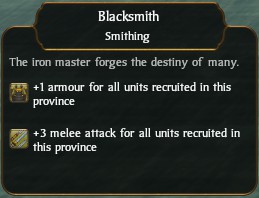
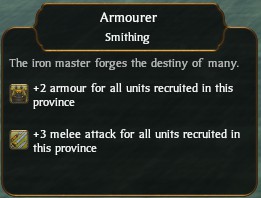
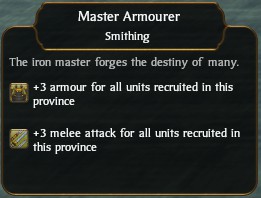
Cost: Free/1350/3500
The Blacksmith increases the melee attack and armour of all units produced in this province. The Armourer further increases the armour of all units produced in this province. The Master Armourer provides legendary armour, rendering units produced in this province almost impervious to all forms of weaponry.
Ingame encyclopaedia - Blacksmith/Armourer/Master Armouer posted:
There are specialist blacksmiths in this province. With the right investment they can specialise in weapons, improving the hand-to-hand combat strengths of units, or in armour, improving units' defensive values. During the Gempei War, swordsmiths were not producing the katana, which is now regarded as typical of the samurai. Its predecessor, the tachi, was still beautifully made, as might be expected of Japanese craftsmen. Armourers were lower down the social order because their craft used leather. Almost without exception around the world, tanning was always a low-status job. Tanners had to handle carcasses, and the tanning process was unbelievably smelly and horrid. The attitude in Japan to tanners took all this into consideration!


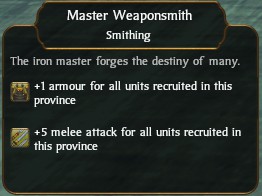
Cost: Free/1350/3500
The Blacksmith increases the melee attack and armour of all units produced in this province. The Weaponsmith further increases the melee attack of all units produced in this province. The Master Weaponsmith provides legendary weaponry, rendering units produced in this province almost unstoppable in melee combat.
Ingame encyclopaedia - Blacksmith/Weaponsmith/Master Weaponsmith posted:
There are specialist blacksmiths in this province. With the right investment they can specialise in weapons, improving the hand-to-hand combat strengths of units, or in armour, improving units' defensive values. During the Gempei War, swordsmiths were not producing the katana, which is now regarded as typical of the samurai. Its predecessor, the tachi, was still beautifully made, as might be expected of Japanese craftsmen. Armourers were lower down the social order because their craft used leather. Almost without exception around the world, tanning was always a low-status job. Tanners had to handle carcasses, and the tanning process was unbelievably smelly and horrid. The attitude in Japan to tanners took all this into consideration!
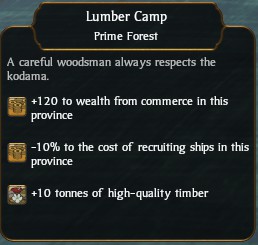
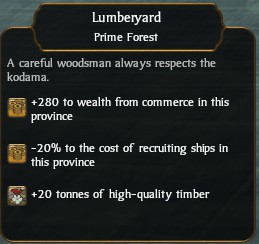
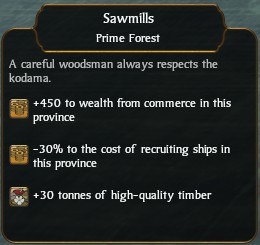
Cost: Free/1350/2000
The first building of the Lumber chain, Lumber Camp increases town wealth, reduces the cost of building ships in the province and provides the Wood trade good. The second building in the chain, Lumberyard, further increases town wealth, the ship cost reduction and number of Wood trade goods. The final building, Sawmills, further increase town wealth, ship cost reduction and number of Wood trade goods.
Ingame encyclopaedia - Lumber Camp/Lumberyard/Sawmills posted:
If the kodama are properly respected, the forests here will flourish. Lumbermen will be able to harvest enough good trees to reduce the cost of any vessels constructed and, through the lumberyard and sawmill, the future cost of ships will be greatly reduced. Extra lumber is useful as a source of wealth too.
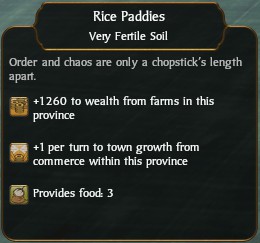
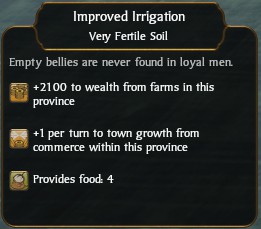
Cost: 1755/4200
Rice Paddies are the third building in the Agriculture chain. They provide an additional food and further increase town wealth based on fertility. The final building in the Agriculture chain is Improved Irrigation. It provides yet another food as well as even further increasing town wealth based on fertility.
Ingame encyclopaedia - Rice Paddies posted:
Paddies are artificially flooded fields where rice is grown. Rice is the staple of all Japanese people, from the lowly peasant harvesting the crop to the mightiest lord enjoying his dinner in exquisite luxury. Even taxes are measured and collected in koku, or measures, of rice. Each province's basic wealth and therefore potential tax yield is determined by its rice output. The unit of tax, the koku, was defined as the amount of rice needed to feed one man for one year. For a lord, then, a koku taken in tax directly represented one basic soldier added to his army; higher ranks would be paid the equivalent of many koku for their services. That it was possible to collect enough surplus rice to support large armies is a tribute to the efficiency of Japanese farmers over many centuries. Starvation was always a harvest away, but it was not as regular or as severe as in, say Europe, during the same period. Relatively speaking, Japanese farmers were far more productive in their work. The constant demand of rice to be paid as taxes, however, could be a terrible burden in lean years but the disloyalty of not paying tax could kill as surely as hunger.
Ingame encyclopaedia - Improved Irrigation posted:
Good farmers always try to get the most of the land that they are working. By using water cleverly, and making sure that it is not wasted, marginal land can be cultivated, effectively increasing the size and effectiveness of farms. The end result is that a province will produce more food and wealth. Japan is a very, very hilly country. It was also densely wooded, and that left little good flat land for food production. By cleverly diverting streams, and using terraced paddy fields, almost every patch of ground in Japan that could be used for growing food was eventually cultivated. The result was a very large, relatively well fed population by medieval standards. There were probably more people in Japan at the time of the Gempei War than in the whole of western Europe.

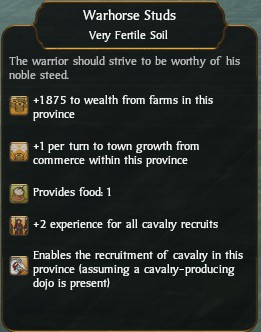
Cost: 1820/4000
The third building in the Pastures chain, Horse Breeders, provides additional town wealth based on fertility and increases the experience of all cavalry units recruited in the province. The final building, Warhorse Studs, even further increases the experience of cavalry recruited in the province, as well as the town wealth based on fertility.
Ingame encyclopaedia - Horse Breeders posted:
Horse breeders improve the quality of cavalry trained in this province. Improving the horse stock leads to better mounts for all cavalry. Mounted combat defined the early samurai, and good horses were naturally valued for their stamina, strength and courage: a warhorse had to be tough as its rider to survive a campaign season, and not flinch from the stress of battle. They also required nearly as much training as the men. A mounted cavalryman had to control his mount, at the gallop, using only his knees so that his hands were free to use a bow. In turn, this required the horse to have spent just as much time being taught to obey absolutely and precisely. Good horses were therefore valued for their potential offspring as well as their immediate use.
Ingame encyclopaedia - Warhorse Studs posted:
For all their power and grace, horses are surprisingly delicate creatures and need a great deal of expensive care and attention. They also need a great deal of space if they are to be healthy and content. In medieval Japan this second requirement was something of a problem. A warlord who had an impressive stable of horses was not only demonstrating his military power, but he was also showing the world that money was no object to his ambitions. Stables and studs need good land and that, in Japan, has always been at a premium. The man who could afford to turn productive farmland into luxurious accommodation for his horses really was rich, important and going to impress his neighbours.
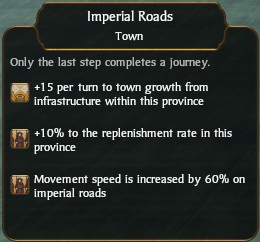
Cost: 3840
Imperial Roads is the fourth and final building in the Roads chain. It dramatically increases town wealth growth, replenishment rate as well as further increasing the movement bonus for road travel.
Ingame encyclopaedia - Imperial Roads posted:
These magnificent roads and their watchtowers significantly improve the movement of armies and agents, economic growth in a province and the replenishment rate for units at the front. Guard stations monitor every traveller, so that the chances of detecting unwelcome enemy agents are greatly increased. As long as the right paperwork exists, travellers can make excellent time. A wrong or falsified internal passport, however, can mean death! The very best medieval Japanese roads were the five great routes created by Tokugawa Ieyasu, radiating out from Edo, long after the end of the Gempei War. They were entirely military in origin: to make sure he could get armies anywhere, quickly. While this was a sensible way of controlling the country, it had the added benefit of improving internal trade. The roads were so sensibly surveyed that the same routes are still in use today.
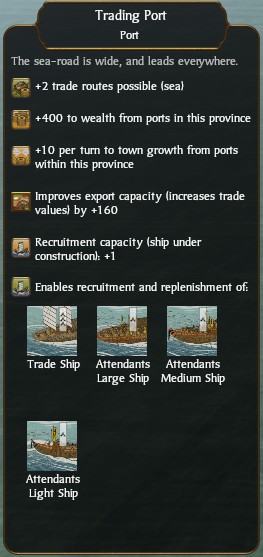
Cost: 2530
A Trading Port adds an additional sea trade route, a boost to town wealth, a substantial boost to town wealth growth as well as a further increase in any trade goods that are exported from this port. It also provides an experience boost to all ships built here. It requires access to the Wood trade good.
Ingame encyclopaedia - Trading Port posted:
Although few nobles would ever admit it, trade is vital to a family's success in war and politics. Trade pays for the strength and influence needed for other two activities. A busy port encourages growth in the rest of the province's economy. Despite the wealth that merchants created, they were not well-regarded in medieval Japanese society. Warriors and nobles were, of course, at the top of the social structure. Farmers and fishermen were commoners, entitled to respect for their work, but without power or status. Merchants, however, had a much lower position because they did no useful, honest "proper" work. Their money was very welcome of course, but not the merchants themselves. The money men would eventually have the last laugh, though, when Japan opened up to the modern world.
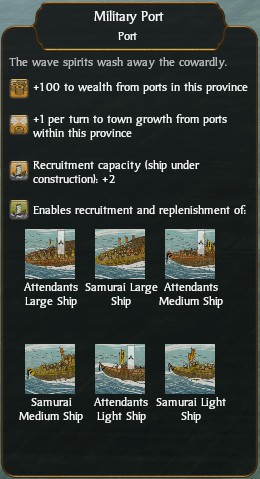

Cost: 1020/2700
The Military Port increases the number of recruitment slots for ships by 1, allowing the construction of two ships at once. It also allows the construction of the Samurai Light, Medium and Heavy ships, as well as increasing the experience of all Attendant ships produced here by 1. A Drydock increases the town wealth of the province as well as adding a further recruitment slot for ships, in addition to allowing the construction of the Firebomb ship. It increases the experience of all ships produced by the Military Port by an additional 2. The Drydock requires access to the Wood trade good.
Ingame encyclopaedia - Military Port posted:
A military port builds and repairs warships, a specialised task that requires specialised yards and specialist craftsmen. Warships must, of course, be built to withstand not only the power of the sea, but everything the enemy can throw at them. Japanese warships were not the same as those of most other medieval navies. Rather than attacking a an enemy ship's structure with large weapons, Japanese ships acted as floating platforms for boarding actions. The crew were the targets of any attacks. The intention in any naval engagement was always to close with the enemy, grapple, and then fight a land battle across the lashed-together ships. This meant that a relatively large crew of soldiers was required, resulting in horrendous casualties in most naval engagements. The losing side simply could not run away from a sea battle; what few prisoners were taken would often be tossed overboard at the end of the battle, or the losers would throw themselves into the sea. This happened at the decisive Battle of Dan-no-ura in 1185, that brought the Gempei War to a close.
Ingame encyclopaedia - Drydock posted:
A drydock is a basin that can be drained for shipbuilding work, and then flooded when a vessel is completed. This allows very large ships to be built safely and then gently floated out when complete. The process of draining and flooding the dock is dependent upon the tides, with lock gates being left open at particularly low tides, and then closed just as the tide turns. This minimises the work to get any remaining water out of the dock. Although slow and cumbersome to operate, a drydock lets shipwrights construct and repair the most powerful vessels invented to date. Historically, it was not until the Sengoku Jidai that the Japanese started building large warships, and even then not for any national fleet. Most Japanese vessels resembled nothing so much as floating castles, probably because of a lack of credible long range anti-ship weaponry such as cannons. Instead, Japanese naval battles nearly always came to be large scale boarding actions, where individual valour and aggression mattered more than seamanship. Unfortunately, this also meant that casualties in naval battles tended to be severe, as ship's crews often had little choice but to fight to the death.


Cost: 2050/3800
The second building in the Silk Farms speciality, the Silk Spinner further increases the town wealth and number of Silk trade goods. The final building, Master Silk Spinner, even further increases the town wealth and number of Silk trade goods.
Ingame encyclopaedia - Silk Workshop/Silk Spinner/Master Silk Spinner posted:
Silk has always been a wondrous commodity, no matter where the cloth was traded. The silk weavers in this province can bring in a great deal of wealth to the lord who invests wisely in their enterprise. From the most ancient of times silk was a symbol of power, luxury and mystery. From Asia it travelled all the way along the fabled Silk Road - a series of caravan routes in reality - all the way to Europe. There it was treated as an almost magical material, its sheer cost meaning only the richest and most powerful could possibly wear it. Sumptuary laws governing the clothes of every social class made the punishments for wearing high-status clothes singularly unpleasant. Oddly, wearing silk was also controlled by Japanese versions of sumptuary laws: clothes made the man in every part of the world. And in every part of the world, nothing said wealth, opulence and power like silk.